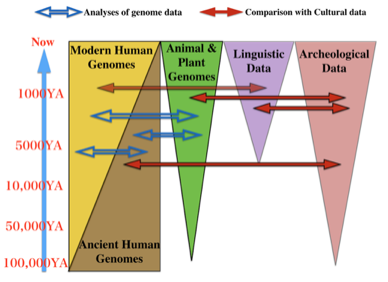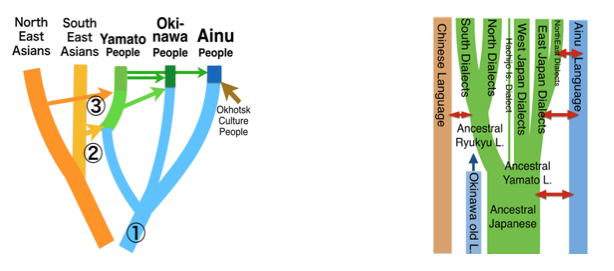
MEXT (Ministry of Education, Culture, Sports, Science and Technology), Japan
Grant-in-Aid for Scientific Research on Innovative Areas FY2018-2022
Yaponesian Genome
- Deciphering Origin and Establishment of Yaponesians mainly based on Genome Sequences -
【Purpose of the Research Project】
Project Leader: SAITOU Naruya, Professor, National Institute of Genetics, Division of Population Genetics, Mishiuma
Six Research Groups
A01: Modern human genome analyses (PI: SAITOU Naruya)
A02: Ancient human genome analyses (PI: Kenichi Shinoda, Vice Director, National Museum of Science and Nature, Tokyo&Tsukuba)
A03: Animal and plant genome analyses (PI: Hitoshi Suzuki, Professor, Hokkaido University, Sapporo)
B01: Archelogical analyses (PI: Shinichiro Fujio, Professor, National Museum of Japanese History, Sakura)
B02: Linguistic analyses (PI: Mitsuaki Endo, Professor, Aoyama Gakuin University, Tokyo)
B03: Large scale genome analyses (PI: Naoki Osada, Associate Professor, Hokkaido University, Sapporo)
People reached Yaponesia (Japanese Archipelago) around 40,000 years ago for the first time, and many waves of migration occurred after that time. Within this framework, we seek to decipher the genomic history of Yaponesians (people on Japanese Archipelago) through determination and comparative analyses of many modern and ancient human genomes. We also analyze genome data of animals and plants which moved to Yaponesia with Yaponesians. Temporal changes of population size are also estimated from genome sequence data by using existing methods and newly developed methods. Because we need to examine history of Yaponesians from many aspects, archeology with special reference to age estimation (dating) of artifacts and ancient organisms and linguistics with special reference to dialect analyses of Japanese and Ryukyuan languages will have collaborative fusion study with evolutionary genomics. We aim to establish new discipline, “genome history” of Yaponesians, through integration of these various analyses.

【Content of the Research Project】
Collect modern Yaponesian DNA samples from various geographical area, and examine the three-migration hypothesis by analyzing their genome sequences (A01 and B03 groups). Extract DNAs from ancient Yaponesian of archeological sites in various periods and area, and compare their genome sequences with modern ones including analyses on natural selection and disease related genomic changes (A02, A01, B03 groups). Analyze genome sequences of animal and plant species and use them for estimating timings of human migrations to Yaponesia and interactions with continental people (A03 and B03 groups). Examine artifacts found from archeological sites of various periods and area with special reference of detailed dating (B01 and A02 groups). Examine dialect data of Japanese and Ryukyuan languages in detail and also infer phylogenetic relationship of Japanese by comparing genome data (B02, A01, A02, B03 groups). Develop new theories to estimate population size change and selection coefficient changes during very short time scale (B03, A01 groups). Study different area of interdisciplinary researches not covered by A01-A03 and B01-B03 groups in A04 and B04 publicly offered groups. We publish magazine “Yaponesian”, as well as supporting global collaborations and assisting career development of young researchers.

【Expected Research Achievements and Scientific Significance】
# Clarify periods and source populations of Yaponesia within the framework of Out-of-Africa dispersal of anatomically modern humans.
# Clarify population size changes of Yaponesians and their ancestors and estimate major migration times.
# Estimate locations and periods of migrants to Yaponesia.
# Clarify correlations between arrivals of cultural elements and human migrations from comparison of archeological data and mutational changes of genomic DNA.
# Estimate the rate of changes of languages spoken in Yaponesia and narrow down language family that may be phylogenetically closer to Japanese.